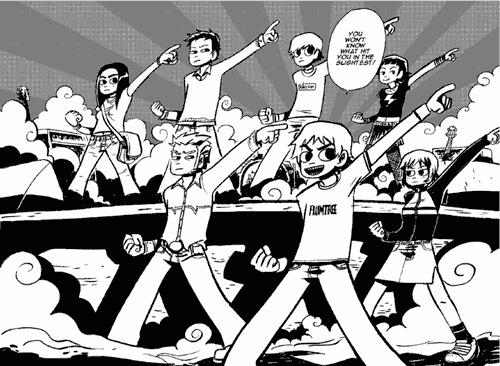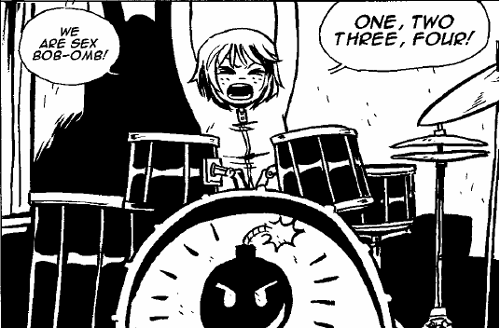- Albert
- Well, the interconnection thing is definitely true!
- Tommy
- Yeah, I know! Isn’t it amazing?
- Albert
- Yeah!
- Tommy
- But it’s also nothing special.
- Albert
- Right, because it rises from the manure of human drama.
- Tommy
- So, what are you doing tomorrow?
- Albert
- Well, I was thinking about chaining myself to a bulldozer. Wanna come?
- Tommy
- Sure. Should I bring my own chains?
- Albert
- We always do.
That’s probably not an exact quote, but I did my best to remember the dialogue from the closing scene of David O. Russell’s I ♥ Huckabees. The “interconnection thing” is a.k.a. the Blanket Theory, of which the Jaffes, existential detectives, are the leading proponents: All the matter and energy in the universe are connected, everything affects everything else. If you think your life is bad—if, e.g., a middle manager in the Huckabees Corporation has invaded your environmentalist coalition and turned it into a PR vehicle, or if you’re a firefighter who’s been in the grip of existential crisis since “that big September thing”* and can’t stand all the hypocritical petroleum users calling you a hero—well, moments of traumatic crisis are the perfect opportunity to dismantle your alienated identity, look at the big picture, see the Blanket, and recognize your interconnectedness. Everything is the same even if it’s different. Your journey to enlightenment will bring a little more enlightenment to the entire universe. This is what Vivian and Bernard Jaffe are trying to show environmentalist and amateur poet Albert Markovski and firefighter Tommy Corn as they investigate their respective existential crises.
But—what about Brad Stand, the Huckabees executive who’s turned Albert’s coalition into a Huckabees promotional machine, and all those petroleum-using selfish people(for example, Tommy’s wife, who doesn’t care what life means and would prefer simply to live it, preferably without philosophers like Tommy hanging around)? If everything’s connected and everything’s great, why do Albert and Tommy keep getting fucked over by everybody around them? The Jaffes can’t answer that question for them. (Albert doesn’t really want them to—he only wants to know why he keeps coincidentally(?) running into the same African man—but Bernard Jaffe pushes him into examining the Blanket Theory, which leads to hard questions about the basic indecency of people that the Jaffes fail to answer to Albert’s satisfaction.) Who can answer it? Caterine Vauban, a French existentialist, archenemy of the Jaffes, who teaches Albert and Tommy her philosophy of “cruelty, manipulation, meaninglessness.” A state of pure being (what the Jaffes would think of as seeing the Blanket, but according to Vauban’s teaching involves getting hit in the face with a large rubber ball) is obtainable but ephemeral. Human drama is inevitable, and you’ll find yourself kicked out of your pure being as soon as, for example, your best friend and your philosophy instructor dump you to go have sex in the woods. Vauban’s pure being, contra the Jaffes, is pure disconnection from the universe, and her concept of human relationships leads inevitably to alienation—no Blanket here. Life is absurd.
The movie’s plot, then (and there is one), is dialectic, with Vauban’s nihilism the antithesis to the Jaffes’ feel-good answer to the existentialist dilemma. Is there synthesis? Yes†, as Albert and Tommy work out in the dialogue quoted above. Everything is connected and everything affects everything else, but realizing this isn’t the key to happiness and inner peace, because the connections run through Vauban’s “human drama,” which includes the bad stuff (cruelty, manipulation, betrayal) in addition to warm fuzzy feelings.
The Blanket Theory is visually represented in the movie by a special effect in which little blocks (usually containing eyes or lips or noses) detach from their positions onscreen and float about interconnecting with one another. The blocks usually float in a disorganized jumble—they represent the inner perceptions of Albert and Tommy, who certainly don’t perfectly perceive the Blanket. But at the turning point of the movie, the pieces slide into place: Brad Stand is weeping (his house has just burnt down), Caterine Vauban (the arsonist with Albert’s help) snaps a Polaroid of him and hands it to Albert, who watches the features of his own face detach, float to the photo, and superimpose themselves on Brad’s face. A moment of pure empathy. Everything is the same—even if it’s different. Albert knows how Brad feels. The fact that Albert caused Brad’s despair by setting fire to his house only tightens this moment of human interconnection.
* Any story that takes on existential philosophy and the absurdity of the world must take on the terrorist attacks of 11 September 2001—maybe especially one that uses “liberal-left despair” (Manohla Dargis, New York Times) as its Muse. “That big September thing” is the only direct mention of 9/11. The way Lily Tomlin, playing Vivian Jaffe, hesitates almost imperceptibly before saying it is at the heart of the lovely subtlety that slips around beneath the movie’s explosive mania and rewards viewers who pay attention.
† Although Rose seems to have an idea that the movie’s conclusion is deconstructive rather than synthetic, or perhaps both. Or that the entire movie is deconstructive or something. I’m sure she’ll comment and explain herself.

